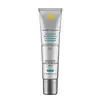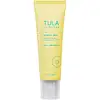What's inside
What's inside
 Key Ingredients
Key Ingredients

 Benefits
Benefits

 Concerns
Concerns

 Ingredients Side-by-side
Ingredients Side-by-side

Water
Skin ConditioningAlcohol Denat.
AntimicrobialEthylhexyl Triazone
UV AbsorberDrometrizole Trisiloxane
UV AbsorberIsononyl Isononanoate
EmollientIsopropyl Lauroyl Sarcosinate
Skin ConditioningButyl Methoxydibenzoylmethane
UV AbsorberDiisopropyl Sebacate
EmollientBis-Ethylhexyloxyphenol Methoxyphenyl Triazine
Skin ConditioningNiacinamide
SmoothingDimethicone
EmollientMethylene Bis-Benzotriazolyl Tetramethylbutylphenol
UV FilterOctocrylene
UV AbsorberPropanediol
SolventEthylhexyl Salicylate
UV AbsorberCetearyl Alcohol
EmollientSilica
AbrasiveTranexamic Acid
AstringentTocopherol
AntioxidantPhenoxyethanol
PreservativePEG-10 Dimethicone
Skin ConditioningCI 77891
Cosmetic ColorantPolyglyceryl-10 Laurate
Skin ConditioningSodium Stearoyl Glutamate
CleansingCaprylyl Glycol
EmollientButylene Glycol
HumectantCetearyl Glucoside
EmulsifyingMica
Cosmetic ColorantGlycerin
HumectantPEG-20
HumectantAmmonium Acryloyldimethyltaurate/Vp Copolymer
Trisodium Ethylenediamine Disuccinate
Carbomer
Emulsion StabilisingInulin Lauryl Carbamate
Emulsion StabilisingT-Butyl Alcohol
PerfumingWater, Alcohol Denat., Ethylhexyl Triazone, Drometrizole Trisiloxane, Isononyl Isononanoate, Isopropyl Lauroyl Sarcosinate, Butyl Methoxydibenzoylmethane, Diisopropyl Sebacate, Bis-Ethylhexyloxyphenol Methoxyphenyl Triazine, Niacinamide, Dimethicone, Methylene Bis-Benzotriazolyl Tetramethylbutylphenol, Octocrylene, Propanediol, Ethylhexyl Salicylate, Cetearyl Alcohol, Silica, Tranexamic Acid, Tocopherol, Phenoxyethanol, PEG-10 Dimethicone, CI 77891, Polyglyceryl-10 Laurate, Sodium Stearoyl Glutamate, Caprylyl Glycol, Butylene Glycol, Cetearyl Glucoside, Mica, Glycerin, PEG-20, Ammonium Acryloyldimethyltaurate/Vp Copolymer, Trisodium Ethylenediamine Disuccinate, Carbomer, Inulin Lauryl Carbamate, T-Butyl Alcohol
Butyl Methoxydibenzoylmethane
UV AbsorberHomosalate
Skin ConditioningEthylhexyl Salicylate
UV AbsorberWater
Skin ConditioningButyloctyl Salicylate
Skin ConditioningPentylene Glycol
Skin ConditioningLactococcus Ferment Lysate
Skin Conditioning1,2-Hexanediol
Skin ConditioningSilica
AbrasiveEctoin
Skin ConditioningGlycerin
HumectantArginine
MaskingHydroxyectoin
BufferingAnanas Sativus Fruit Extract
Skin ConditioningCarica Papaya Fruit Extract
Skin ConditioningLactic Acid
BufferingCamellia Sinensis Leaf Extract
AntimicrobialHedychium Coronarium Root Extract
MaskingTriethyl Citrate
MaskingCitrus Aurantium Dulcis Peel Extract
Emulsion StabilisingCitrus Limon Peel Extract
EmollientPyrus Communis Fruit Extract
Skin ConditioningPyrus Malus Fruit Extract
Skin ConditioningRubus Idaeus Fruit Extract
AstringentVanilla Planifolia Fruit Extract
Skin ConditioningPimpinella Anisum Fruit Extract
MaskingMica
Cosmetic ColorantTocopherol
AntioxidantAmmonium Acryloyldimethyltaurate/Vp Copolymer
Synthetic Fluorphlogopite
Hydrolyzed Wheat Protein/Pvp Crosspolymer
Carbomer
Emulsion StabilisingDibutyl Lauroyl Glutamide
Skin ConditioningDibutyl Ethylhexanoyl Glutamide
Skin ConditioningPropanediol
SolventTrisodium Ethylenediamine Disuccinate
Sodium Chloride
MaskingSodium Benzoate
MaskingEthylhexylglycerin
Skin ConditioningTin Oxide
AbrasivePhenoxyethanol
PreservativeButyl Methoxydibenzoylmethane, Homosalate, Ethylhexyl Salicylate, Water, Butyloctyl Salicylate, Pentylene Glycol, Lactococcus Ferment Lysate, 1,2-Hexanediol, Silica, Ectoin, Glycerin, Arginine, Hydroxyectoin, Ananas Sativus Fruit Extract, Carica Papaya Fruit Extract, Lactic Acid, Camellia Sinensis Leaf Extract, Hedychium Coronarium Root Extract, Triethyl Citrate, Citrus Aurantium Dulcis Peel Extract, Citrus Limon Peel Extract, Pyrus Communis Fruit Extract, Pyrus Malus Fruit Extract, Rubus Idaeus Fruit Extract, Vanilla Planifolia Fruit Extract, Pimpinella Anisum Fruit Extract, Mica, Tocopherol, Ammonium Acryloyldimethyltaurate/Vp Copolymer, Synthetic Fluorphlogopite, Hydrolyzed Wheat Protein/Pvp Crosspolymer, Carbomer, Dibutyl Lauroyl Glutamide, Dibutyl Ethylhexanoyl Glutamide, Propanediol, Trisodium Ethylenediamine Disuccinate, Sodium Chloride, Sodium Benzoate, Ethylhexylglycerin, Tin Oxide, Phenoxyethanol
 Reviews
Reviews

Ingredients Explained
These ingredients are found in both products.
Ingredients higher up in an ingredient list are typically present in a larger amount.
Ammonium Acryloyldimethyltaurate/Vp Copolymer (let's call it AAVC for short) is a synthetically created polymer. It's used as a film-forming agent and used to thicken the consistency of products.
AAVC is able to increase the consistency and viscosity of products due to its large molecule size. It also prevents ingredients from separating.
Also known as Avobenzone, this ingredient is a chemical sunscreen filter that provides protection in the UV-A range.
Avobenzone is globally approved and is the most commonly used UV-A filter in the world.
Studies have found that avobenzone becomes ineffective when exposed to UV light (it is not photostable; meaning that it breaks down in sunlight). Because of this, formulations that include avobenzone will usually contain stabilizers such as octocrylene.
However, some modern formulations (looking at you, EU!) are able to stabilize avobenzone by coating the molecules.
Avobenzone does not protect against the UV-B range, so it's important to check that the sunscreen you're using contains other UV filters that do!
The highest concentration of avobenzone permitted is 3% in the US, and 5% in the EU.
Learn more about Butyl MethoxydibenzoylmethaneCarbomer is a polymer of acrylic acid. Its main role is to create a gel consistency.
A high amount of carbomer can cause pilling or balling up of products. Don't worry, most products contain 1% or less of carbomer.
Ethylhexyl Salicylate is an organic compound used to block UV rays. It primarily absorbs UVB rays but offers a small amount of UVA protection as well.
Commonly found in sunscreens, Ethylhexyl Salicylate is created from salicylic acid and 2-ethylhexanol. You might know salicylic acid as the effective acne fighter ingredient and BHA.
The ethylhexanol in this ingredient is a fatty alcohol and helps hydrate your skin, similar to oils. It is an emollient, which means it traps moisture into the skin.
According to manufacturers, Ethylhexyl Salicylate absorbs UV wavelength of 295-315 nm, with a peak absorption at 307-310 nm. UVA rays are linked to long term skin damage, such as hyperpigmentation. UVB rays emit more energy and are capable of damaging our DNA. UVB rays cause sunburn.
Learn more about Ethylhexyl SalicylateGlycerin is already naturally found in your skin. It helps moisturize and protect your skin.
A study from 2016 found glycerin to be more effective as a humectant than AHAs and hyaluronic acid.
As a humectant, it helps the skin stay hydrated by pulling moisture to your skin. The low molecular weight of glycerin allows it to pull moisture into the deeper layers of your skin.
Hydrated skin improves your skin barrier; Your skin barrier helps protect against irritants and bacteria.
Glycerin has also been found to have antimicrobial and antiviral properties. Due to these properties, glycerin is often used in wound and burn treatments.
In cosmetics, glycerin is usually derived from plants such as soybean or palm. However, it can also be sourced from animals, such as tallow or animal fat.
This ingredient is organic, colorless, odorless, and non-toxic.
Glycerin is the name for this ingredient in American English. British English uses Glycerol/Glycerine.
Learn more about GlycerinMica is a naturally occurring mineral used to add shimmer and color in cosmetics. It can also help improve the texture of a product or give it an opaque, white/silver color.
Serecite is the name for very fine but ragged grains of mica.
This ingredient is often coated with metal oxides like titanium dioxide. Trace amounts of heavy metals may be found in mica, but these metals are not harmful in our personal products.
Mica has been used since prehistoric times throughout the world. Ancient Egyptian, Indian, Greek, Roman, Aztec, and Chinese civilizations have used mica.
Learn more about MicaPhenoxyethanol is a preservative that has germicide, antimicrobial, and aromatic properties. Studies show that phenoxyethanol can prevent microbial growth. By itself, it has a scent that is similar to that of a rose.
It's often used in formulations along with Caprylyl Glycol to preserve the shelf life of products.
Propanediol is an all-star ingredient. It softens, hydrates, and smooths the skin.
It’s often used to:
Propanediol is not likely to cause sensitivity and considered safe to use. It is derived from corn or petroleum with a clear color and no scent.
Learn more about PropanediolSilica, also known as silicon dioxide, is a naturally occurring mineral. It is used as a fine, spherical, and porous powder in cosmetics.
Though it has exfoliant properties, the function of silica varies depending on the product.
The unique structure of silica enhances the spreadability and adds smoothness, making it a great texture enhancer.
It is also used as an active carrier, emulsifier, and mattifier due to its ability to absorb excess oil.
In some products, tiny microneedles called spicules are made from silica or hydrolyzed sponge. When you rub them in, they lightly polish away dead skin layers and enhance the penetration of active ingredients.
Learn more about SilicaTocopherol (also known as Vitamin E) is a common antioxidant used to help protect the skin from free-radicals and strengthen the skin barrier. It's also fat soluble - this means our skin is great at absorbing it.
Vitamin E also helps keep your natural skin lipids healthy. Your lipid skin barrier naturally consists of lipids, ceramides, and fatty acids. Vitamin E offers extra protection for your skin’s lipid barrier, keeping your skin healthy and nourished.
Another benefit is a bit of UV protection. Vitamin E helps reduce the damage caused by UVB rays. (It should not replace your sunscreen). Combining it with Vitamin C can decrease sunburned cells and hyperpigmentation after UV exposure.
You might have noticed Vitamin E + C often paired together. This is because it is great at stabilizing Vitamin C. Using the two together helps increase the effectiveness of both ingredients.
There are often claims that Vitamin E can reduce/prevent scarring, but these claims haven't been confirmed by scientific research.
Learn more about TocopherolTrisodium Ethylenediamine Disuccinate is used to help stabilize a product.
It is a chelating agent, meaning it helps prevent metal ions from binding to other ingredients. This prevents unwanted reactions in products. Metal ions can come into a product via the water ingredient. They are found in trace amounts and are not known to be harmful.
Water. It's the most common cosmetic ingredient of all. You'll usually see it at the top of ingredient lists, meaning that it makes up the largest part of the product.
So why is it so popular? Water most often acts as a solvent - this means that it helps dissolve other ingredients into the formulation.
You'll also recognize water as that liquid we all need to stay alive. If you see this, drink a glass of water. Stay hydrated!
Learn more about Water